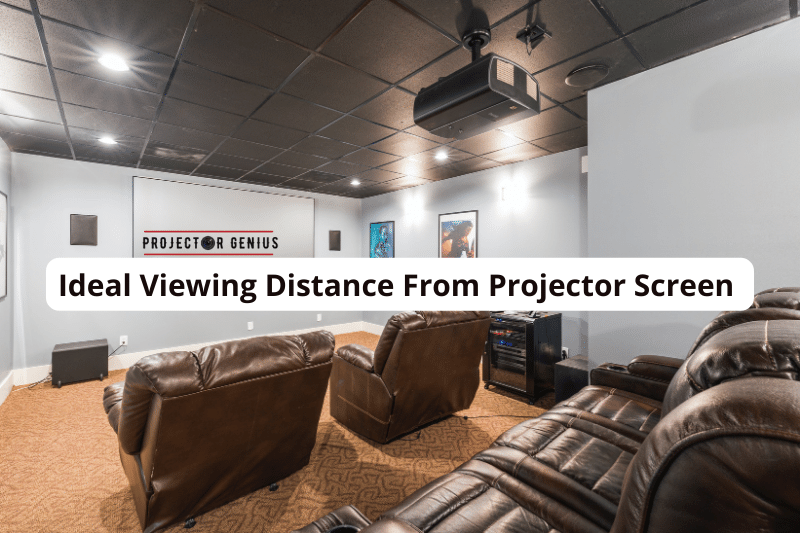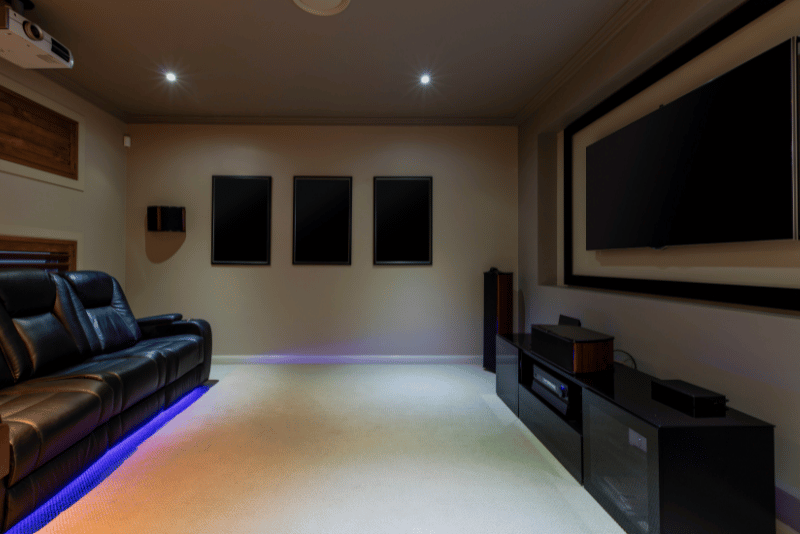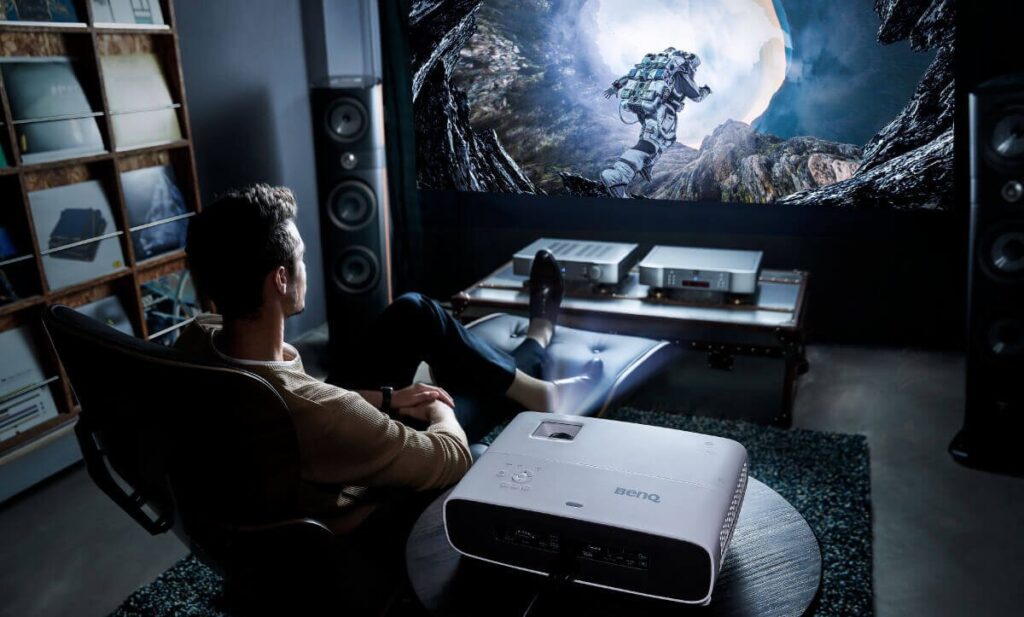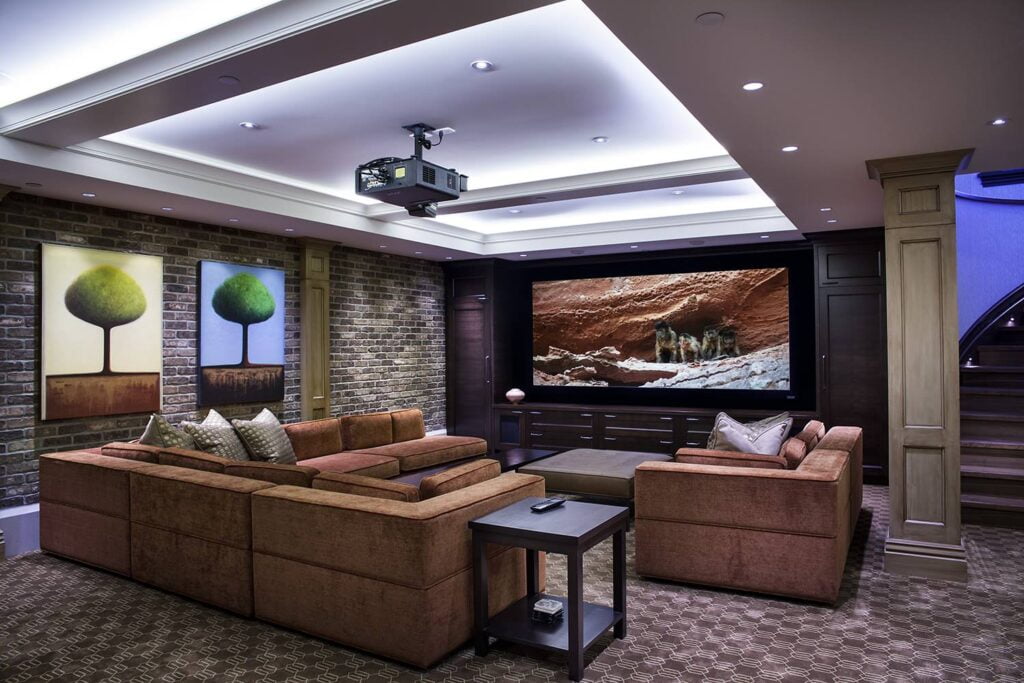Ideal Viewing Distance From Projector Screen [2023 Updated Detailed Guide]
-
 Written by:
Kristy Roger
Written by:
Kristy Roger
- Last Updated:
Hey folks, ever sat too close to a projector screen and felt like you were missing out? Or maybe you sat too far and couldn’t catch the details?
I get it; it’s confusing. You’re in the right spot to solve that puzzle.
Trust me, the distance you choose isn’t trivial; it shapes your whole viewing experience.
Why focus on this? A perfect distance makes movies feel like a cinema adventure and turns presentations into captivating stories.
Whether you’re in a small room or a big hall, this detail matters. Plus, let’s be real, nobody wants to strain their eyes, right?
So, stay with me as we uncover the ideal distance for enjoying your projector screen. Your eyes, and anyone who joins you for movie night, will be grateful!
Ideal viewing distance from projector? I recommend to sit at a distance of approximately 2 times the screen’s diagonal size for the best experience. Adjust based on personal preferences and content type.

I recommend using the Table of Contents to quickly access the information you need.
My article is designed to cater to home cinema users of all levels, from Beginners to Advanced enthusiasts.
Table of Contents
How does Viewing Distance Affect Visual Comfort and Image Quality?
Viewing distance plays a crucial role in both visual comfort and image quality. When you’re too close to a screen, it can lead to discomfort, straining your eyes to take in the entire picture. On the flip side, being too far can make details harder to discern, reducing the overall viewing experience. Finding the right balance is key.
Ideally, you want to sit at a distance that allows you to comfortably take in the entire screen without having to constantly shift your gaze. This not only ensures visual comfort but also enhances image quality. It’s akin to finding that sweet spot in a movie theater where the screen fills your field of vision without being overwhelming.
Moreover, the resolution of the content being displayed factors into this equation. If you’re too close to a low-resolution screen, you might start noticing individual pixels, which can be distracting and diminish image quality. On the other hand, a higher resolution screen allows for a more forgiving viewing distance.
What Factors Influence Viewing Distance from Projector?
Here are the factors that influence the optimal viewing distance from a projector:
Screen Size
- Larger screens generally require a greater viewing distance for comfortable viewing.
- Smaller screens allow for closer viewing positions.
Resolution of Content
- Higher resolution content allows for a more forgiving viewing distance.
- Lower resolution content may require a slightly farther viewing position to maintain image quality.
Room Layout and Available Space
- Compact rooms may limit how far viewers can position themselves from the screen.
- Furniture arrangement and room elements influence the ideal viewing distance.
Ceiling Height
- Low ceilings may restrict how high or low the projector can be mounted, affecting the optimal viewing distance.
Personal Preference and Comfort
- Individual visual preferences and comfort levels play a part in determining the ideal viewing distance.
By considering these factors, one can ensure that the viewing experience is tailored to meet specific preferences and needs.
Recommendations for Ideal Viewing Distance from Projector?
Based on my experience, here are some honest recommendations for the ideal viewing distance from a projector:
Screen Size Matters
- For smaller screens sizes (around 40-60 inches), a viewing distance of approximately 6.7 to 11.1 feet provides a clear and comfortable experience.
- Medium-sized screens (around 80-100 inches) are best viewed from about 13.3 to 22.2 feet away for an immersive feel.
- Larger screens (120 inches and above) offer an excellent experience when viewed from around 20 to 33.3 feet.
Resolution Consideration
- With standard HD (1080p) content, a viewing distance that allows you to fully engage with the screen is beneficial.
- For 4K content, you can sit closer without sacrificing image quality due to the higher resolution.
Room Layout and Size
- In smaller rooms, consider the available space. Ensure that the viewing distance allows for a comfortable and clear view of the entire screen.
Personal Preference
- Tailor the viewing distance to your own comfort and preferences. Some may prefer a more immersive experience, while others might opt for a more relaxed viewing position.
Avoid Straining
- Steer clear of sitting too close, as this can lead to eye strain. Likewise, sitting too far can result in details becoming harder to discern.
Test and Adjust
- Experiment with different distances to find the one that suits you best. This may involve some trial and error, but it’s worth it for an optimal viewing experience.
Remember, these are general guidelines. Personal preferences and room layouts can influence the ideal viewing distance. By taking these recommendations into account, you’re likely to find a distance that offers both comfort and visual clarity for your projector setup.
How do Room Dimensions, Furniture Placement, and Seating Arrangement impact Viewing Distance?

Room dimensions, furniture placement, and seating arrangement are crucial factors in determining the ideal viewing distance for a projector setup.
In a smaller room, a closer viewing distance ensures a comfortable view of the entire screen. In contrast, larger rooms allow for a more immersive experience from a greater distance. Furniture placement plays a pivotal role; positioning it appropriately ensures viewers have ample space to enjoy the content without feeling cramped.
Seating arrangement is equally important; finding the right balance ensures every viewer has an optimal vantage point. Additionally, considering potential obstacles and having flexible furniture allows for easy adjustments, ensuring an unobstructed view. By carefully weighing these factors, an optimal viewing environment can be created for any projector setup.
How does Viewing Distance Interact with Different Types of Content such as Movies, Presentations, and Gaming?
Viewing distance interacts distinctly with various types of content like movies, presentations, and gaming. Let’s break down how it influences each:
Movies
When it comes to movies, a slightly farther viewing distance tends to be ideal. This allows for a wider field of vision, which complements the cinematic experience. It’s like being in a theater, where the screen encompasses your vision, providing an immersive escape into the film’s world. This setup also ensures you can take in all the details and action sequences without straining your eyes.
Presentations
For presentations, a closer viewing distance is advantageous. This allows you to focus on finer details like text, graphs, and charts. Being nearer to the screen ensures that the content remains legible and clear, which is crucial for effective communication. It’s akin to sitting at the front of a conference room during a presentation, allowing for a direct and comprehensive view of the material being presented.
Gaming
Gaming strikes a balance between movies and presentations. A moderately close viewing distance is often preferred. This setup offers a more immersive experience compared to presentations, allowing you to fully engage with the game’s environment. It’s like being right in the midst of the action.
However, it’s not as far as the ideal distance for movies, ensuring you can still catch all the intricate details and movements crucial for gameplay.
Adapting the viewing distance based on the type of content is crucial for an optimal experience. It ensures that you can fully appreciate the nuances and details specific to each category. By finding the right balance, you enhance your overall engagement and enjoyment, whether it’s with a thrilling movie, an informative presentation, or an exhilarating gaming session.
How to Test and Adjust Viewing Distance?
Testing and adjusting viewing distance for a projector setup is a crucial step in ensuring an optimal viewing experience. Here’s an honest guide on how to go about it:
Firstly, it’s essential to familiarize oneself with the specifications provided by the projector’s manual. This includes details related to throw distance, aspect ratio, and resolution. This provides a foundational understanding of the projector’s capabilities.
Next, measure the dimensions of the room, including the distance between the projector and the screen, as well as the distance from the screen to the viewing area. These measurements serve as the basis for determining the appropriate viewing distance.
Utilize the projector’s throw ratio to calculate the suitable screen size. This ratio is derived by dividing the distance from the lens to the screen by the screen width. It aids in determining how far the projector should be placed from the screen.
Temporary screens, such as a white wall or a portable screen, can be used for initial testing. This allows for experimentation with different sizes and distances before committing to a permanent installation. Test patterns or grid lines can be helpful tools for aligning the image accurately.
Fine-tune the image size and clarity using the projector’s zoom and focus controls. This step ensures that the image is clear and well-defined, without any distortion or blurriness.
Ensure that the aspect ratio of the projected image matches that of your screen. This prevents any image distortion or stretching, maintaining an accurate representation of the content.
Test the setup from various viewing distances to evaluate the clarity and comfort of the image. This involves sitting in different parts of the room to ensure that the image remains clear and enjoyable from various vantage points.
Play different types of content that you plan to use regularly. This provides a practical assessment of how well the setup works for your specific needs. It allows you to identify any adjustments that may be necessary for different types of content.
Test the setup under various lighting conditions to evaluate how well the image holds up in both dark and bright settings. This ensures that the viewing experience remains consistent regardless of ambient light levels.
If possible, gather feedback from potential viewers to ensure that the viewing distance is comfortable for everyone. This step helps in fine-tuning the setup to cater to the preferences of a diverse audience.
Lastly, perform a final calibration to optimize color, contrast, and brightness once you’ve settled on a screen size and viewing distance. This ensures that the image quality is maximized for the chosen setup.
Viewing Distance from Projector Frequently Asked Questions (FAQs)
Can I Sit Closer to the Screen for Higher-Resolution Projectors?
Higher-resolution projectors offer more pixels, which means that the image is sharper and clearer. This increased pixel density allows viewers to sit closer without noticing any pixelation or loss of image quality. It’s akin to looking at a high-quality photograph up close – the details remain crisp and well-defined.
However, there’s a caveat to keep in mind. While higher-resolution projectors allow for closer seating, it’s important not to overdo it. Sitting excessively close can still lead to discomfort or eye strain. It’s about finding the sweet spot that strikes a balance between immersion and comfort.
What if my Room Layout Doesn’t Allow for the Ideal Viewing Distance?
If my room layout doesn’t allow for the ideal viewing distance, I’ll need to get creative. Shifting furniture and reconfiguring the setup could make a difference.
If that’s not enough, considering a different screen size or projector with a compatible throw ratio might do the trick. It’s about finding practical solutions to ensure a comfortable viewing experience within the confines of the room’s layout.
Does Viewing Distance Affect Eye Strain During Extended Sessions?
Viewing distance does indeed play a crucial role in preventing eye strain during extended viewing sessions. When the distance is too short, it forces the eyes to work harder to focus on the screen, leading to discomfort and fatigue. On the flip side, if the viewing distance is too far, it can strain the eyes as they struggle to discern finer details. Striking the right balance ensures that the eyes can comfortably take in the content without unnecessary strain.
Furthermore, an appropriate viewing distance allows for natural eye movements, reducing the need for constant adjustments. This promotes a more relaxed viewing experience, especially during extended sessions. It’s akin to holding a book at an optimal distance for reading – the text is clear, and the eyes don’t have to strain to follow along.
In addition, considering the resolution of the content being displayed is vital. Higher resolution projectors can support closer viewing distances without compromising clarity. This means viewers can enjoy a more immersive experience without putting undue stress on their eyes.
Is there a Standard Formula to Calculate Viewing Distance?
In my experience, there isn’t a one-size-fits-all standard formula for calculating viewing distance. It’s a bit more nuanced than that. However, there are guidelines and considerations that can help determine an appropriate viewing distance for a projector setup.
One crucial factor is the screen size. Generally, the diagonal screen size is taken into account. Then, you consider the resolution of the content being displayed. Higher resolution content can be comfortably viewed from closer distances.
The next consideration is the viewer’s visual comfort. It’s important to find a distance that allows viewers to take in the entire screen comfortably without straining their eyes. This can vary from person to person based on their individual vision and preferences.
Another key element is the projector’s specifications, particularly its throw ratio. This ratio helps determine how far the projector needs to be from the screen to achieve a specific image size. Understanding the throw ratio is crucial in finding the right viewing distance.
Lastly, room dimensions play a significant role. A larger room may allow for a greater viewing distance, while a smaller room might necessitate a closer seating arrangement.
Can I Watch Content Comfortably if My Viewing Distance is Shorter Than Recommended?
Based on my experience, if the viewing distance is shorter than recommended, it can lead to some discomfort. It’s akin to sitting too close to a movie screen in a theater; you might find yourself constantly adjusting or straining your eyes to take in the whole picture. This can potentially lead to eye fatigue or even headaches, especially during extended viewing sessions.
However, it’s not all doom and gloom. In some cases, viewers may adapt and become accustomed to a shorter distance. It’s like getting used to reading fine print up close. Over time, your eyes may adjust, but it’s not an ideal or comfortable long-term solution.
Ultimately, while it’s possible to watch content with a shorter viewing distance, it’s not recommended for extended periods. It’s crucial to find a viewing distance that aligns with recommended guidelines to ensure a comfortable and enjoyable viewing experience without straining your eyesS
Final Thoughts
Selecting the ideal viewing distance for a projector setup involves a delicate balance of factors, including screen size, content resolution, personal comfort, and room dimensions.
While there isn’t a one-size-fits-all formula, considering these elements collectively guides viewers toward an optimal distance that ensures both visual clarity and comfort.
A closer distance enhances immersion, while a farther one allows for a wider field of vision. It’s crucial to avoid extremes, as sitting too close or too far can result in discomfort and eye strain.
In essence, finding the right viewing distance enhances the overall viewing experience, making it more enjoyable and accommodating for all viewers.
Author of this Post:

Kristy Roger
Home Cinema Consultant & Tech Enthusiast
Holding a background in Industrial and Electrical Technology from the University of Alberta, Kristy has spent 5+ years consulting on home theater products at a top electronics firm. As a certified Technical Professional with Lean Six Sigma credentials, Kristy expertise ranges from projector nuances to hands-on experience with leading models. Kristy have been sharing her knowledge online for two years, blending professional insights with personal experiences from her own home cinema setup. Off the screen, She is a dedicated mom to Jerry, Ryan, and our two pups, Cuddle and Paw.





